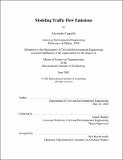Modeling Traffic Flow Emissions
Author(s)
Cappiello, Alessandra
DownloadAlessandra's_Thesis.pdf (4.067Mb)
Metadata
Show full item recordAbstract
The main topic of this thesis is the development of light-duty vehicle dynamic emission models and their integration with dynamic traffic models. Combined, these models
constitute fundamental components to support the development and assessment of traffic
management policies, and the optimization of their parameters, to alleviate the negative
impacts of road traffic.
We develop and implement a dynamic model of emissions (CO2, CO, HC, and NOx) and
fuel consumption for light-duty vehicles. The model is derived from regression-based and
load-based emissions modeling approaches, and effectively combines their respective
advantages. The model is calibrated for two vehicle categories using FTP as well MEC01
driving cycles data. The US06 driving cycle is used to validate the estimation capabilities of
the proposed model. The preliminary results indicate that the model gives reasonable results
compared to actual measurements as well to results obtained with CMEM, a well-known
load-based dynamic emission model. Furthermore, the results indicate that the model runs
fast, and is relatively simple to calibrate. We propose a framework for the integration of dynamic emission models with nonmicroscopic
dynamic traffic models, that do not estimate vehicle acceleration. A probabilistic model of acceleration is designed and implemented to link the traffic and the emission models. The model provides an experimental distribution of the accelerations for
any given speed and road type. The framework is applied to integrate the dynamic emission
model developed in this thesis with a mesoscopic dynamic traffic flow model. Using a
hypothetical case study, we illustrate the potential of the combined models to estimate the effects of route guidance strategies, which are one of numerous examples of dynamic traffic
management strategies, on traffic travel times and traffic emissions. In presence of
incidents, it is shown that route guidance can reduce total travel times as well as total
emissions.
Date issued
2002-09-17Keywords
dynamic traffic models, traffic flow emissions